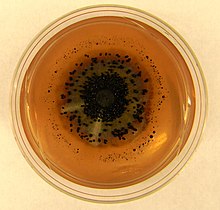| DavidAnstiss/Xylonales | |
|---|---|

| |
| Four-week old culture of Xylona heveae growing on Potato dextrose agar | |
| Scientific classification | |
| Kingdom: | |
| Division: | |
| Class: | |
| Order: | Xylonales
|
| Family: | Xylonaceae Gazis & P. Chaverri [1]
|
| Family | |
|
Xylonaceae | |
The Xylonales are a order of fungi holding the monotypic family of Xylonaceae Gazis & P. Chaverri, within the class Xylonomycetes.[2]
They are parasitic on plants or saprobic on rotten wood. ???
Xylonales Gazis & P. Chaverri
Xylonaceae Gazis & P. Chaverri
- Trinosporium Crous & Decock (1 species, Trinosporium guianense Crous & Decock (2012))[3]
- Xylona Gazis & P. Chaverri (1 species, Xylona heveae (Gazis & P. Chaverri (2012))[1]
Trinosporium was placed in Incertae sedis, Pleosporales order, Pleosporomycetidae class Isolated as contaminant in the rainforest of French Guiana[4]
Xylona was placed in Xylonaceae, Xylonales, Xylonomycetes, Isolated from the sapwood of Hevea brasiliensis (the Rubber tree) in Peru,[5]
The resinicolous fungi Sarea difformis and S. resinae (Sareomycetes) were taxonomically revised on the basis of morphological observations and phylogenetic analyses of the nucleotide sequences of the nSSU-LSU-rpb1-rpb2-mtSSU genes. The results of phylogenetic analyses show that S. difformis and S. resinae are grouped with members of Xylonomycetes. According to the results of phylogenetic analyses and their sexual and asexual morphs resemblance, Sareomycetes is synonymized with Xylonomycetes. Although Tromera has been considered a synonym of Sarea based on the superficial resemblance of the sexual morph, we show that they are distinct genera and Tromera should be resurrected to accommodate T. resinae (= S. resinae). Xylonomycetes was morphologically re-circumscribed to comprise a single family (Xylonaceae) with four genera (Sarea, Trinosporium, Tromera, and Xylona) sharing an endophytic or plant saprobic stage in their lifecycle, ascostroma-type ascomata with paraphysoid, Lecanora-type bitunicate asci, and pycnidial asexual morphs. Phylogenetic analyses based on ITS sequences and environmental DNA (eDNA) implied a worldwide distribution of the species. Although Symbiotaphrinales has been treated as a member of Xylonomycetes in previous studies, it was shown to be phylogenetically, morphologically, and ecologically distinct. We, therefore, treated Symbiotaphrinales as Pezizomycotina incertae sedis.[6]
It contains the wood endophytes in Xylona and the endosymbionts of beetles in Symbiotaphrina.[7] It has been suggested that these seeming unrelated genera might be linked via a yeast-like stage. As an asexual yeast living within the insect guts, with an asexual mycelial form and then a sexual form associated with the dead wood. Although, the frequency of transfer between free-living and symbiotic conditions is unknown and could be very low. As the yeasts are transferred vertically via the ovipositor of the female inset to the egg surface.[8]
References edit
- ^ a b Gazis, R.; Miadlikowska, J.; Lutzoni, F.; Arnold, A.E.; Chaverri, P. (2012). "Culture-based study of endophytes associated with rubber trees in Peru reveals a new class of pezizomycotina: Xylonomycetes". Molecular Phylogenetics and Evolution. 65: 294–304. doi:10.1016/j.ympev.2012.06.019.
- ^ Wijayawardene, Nalin; Hyde, Kevin; Al-Ani, Laith Khalil Tawfeeq; Somayeh, Dolatabadi; Stadler, Marc; Haelewaters, Danny; et al. (2020). "Outline of Fungi and fungus-like taxa". Mycosphere. 11: 1060–1456. doi:10.5943/mycosphere/11/1/8.
- ^ Crous & Decock, in Crous et al., Persoonia 28: 169 (2012)
- ^ "Species Fungorum - Names Record". www.speciesfungorum.org. Retrieved 16 September 2023.
- ^ "Species Fungorum - Names Record". www.speciesfungorum.org. Retrieved 16 September 2023.
- ^ Hashimoto, Akira; Masumoto, Hiroshi; Endoh, Rikiya; Degawa, Yousuke; Ohkuma, Moriya (20 January 2021). "Revision of Xylonaceae ( Xylonales, Xylonomycetes) to include Sarea and Tromera". Mycoscience. 62 (1): 47-63. doi:10.47371/mycosci.2020.11.001.
- ^ Joseph Heitman, Barbara J. Howlett, Pedro W. Crous, Eva H. Stukenbrock, Timothy Yong James and Neil A. R. Gow The Fungal Kingdom (2020), p. 19, at Google Books
- ^ Angela E. Douglas Insects and Their Beneficial Microbes (2022), p. 284, at Google Books
Other sources edit
;Category:Pucciniomycotina ;Category:Fungal plant pathogens and diseases ;Category:Basidiomycota genera